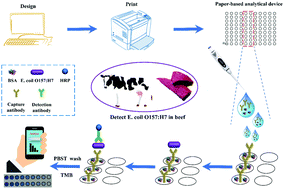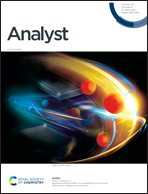Rapid and accurate detection of Escherichia coli O157:H7 in beef using microfluidic wax-printed paper-based ELISA
Abstract
Escherichia coli O157:H7 is a severe foodborne pathogen that causes lots of life-threatening diseases. In the search for a rapid, sensitive, portable and low-cost method to detect this pathogen, we developed a wax-printed paper-based enzyme-linked immunosorbent assay (P-ELISA) based on microfluidic paper-based analytical devices (μPADs), with the whole operation time being less than 3 h and only needing 5 μl samples for detection. The limit of detection (LOD) of E. coli O157:H7 reached 104 CFU ml−1, which is an order of magnitude higher than that of conventional ELISA (C-ELISA). The LOD in artificially contaminated beef samples is 1 CFU per 25 g after enriching the culture for 8 h. This method is superior to the molecular biology method in detection sensitivity and superior to C-ELISA and the national standard method in detection time and cost. Thus, the established P-ELISA method has good sensitivity, specificity and repeatability. It can be suitable for point-of-care testing without expensive and bulky instruments and can also provide a platform for detecting other pathogens, especially in areas that lack advanced clinical equipment.



 Please wait while we load your content...
Please wait while we load your content...